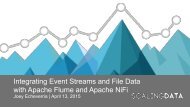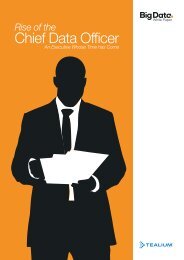NCDS-Summit-2013
NCDS-Summit-2013
NCDS-Summit-2013
You also want an ePaper? Increase the reach of your titles
YUMPU automatically turns print PDFs into web optimized ePapers that Google loves.
Genomic Data: Overall Scope of the Data Science Challenges<br />
The field of genomics has benefitted from numerous advances<br />
in data science. For example, we now have unprecedented<br />
access to massive streams of rich genomic data<br />
from multiple sources, ranging from myriad species to many<br />
thousands of individual human genomes; the cost of collecting/managing/storing<br />
these massive data sets has decreased<br />
significantly, while computing power and memory storage<br />
capacity have increased exponentially; and major advances<br />
have been made in analytical tools and algorithms,<br />
including machine learning, natural language processing,<br />
and informatics (Horvitz and Mitchell, 2010; Kahn, 2011).<br />
Yet while we are now capable of quickly amassing large<br />
volumes of genomic data at a relatively modest cost (Kahn,<br />
2011; Manyika et al., 2011), we do not have adequate analytical<br />
tools, technologies, and policies to federate, process,<br />
synthesize, distill, and apply genomic data sets at a cost<br />
comparable to what is required to generate the data.<br />
“The $1,000 genome, the $100,000 analysis?” —Elaine Mardis, Musing on Genome Medicine,<br />
Critical Challenges in Genomics<br />
Data Provenance, Collection, and Management<br />
Discussion Moderator: Dan Maltbie, Chief Technology Officer, Annai Systems<br />
Dan Maltbie is a Silicon Valley entrepreneur, with over thirty years of experience. Mr. Maltbie has held positions at<br />
GRiD Systems, DiviCom, Woven Systems, Juniper Networks, Hewlett-Packard, and other technology-oriented businesses.<br />
He has contributed to the development of many networking and high performance computing systems for genomics<br />
and a variety of other applications.<br />
Overview: Predicting data repurposing and reuse, while maintaining data provenance, presents challenges to the collection<br />
and management of big data sets. These challenges are amplified by the technological complexities associated with<br />
data derived from multiple sources and incompatible or legacy data management systems. Trained data and information<br />
specialists are required to manage all aspects of the life cycle of genomic data.<br />
Data collection and management are fundamental to<br />
genomics research and clinical application, yet traditional<br />
technologies and tools become less effective on a<br />
large scale. Incompatible standards, formats, and versions<br />
complicate the merging, integration, and reuse of data from<br />
multiple sources; this problem is evident even with small<br />
data sets but becomes tremendously complex when dealing<br />
with large data sets. A related important issue is whether<br />
data sets derived using different sequencing platforms can<br />
be legitimately combined. These issues are exacerbated by<br />
industry, as competition among external vendors encourages<br />
the differentiation and incompatibility of systems (Digital<br />
Standards Organization [Digistan], <strong>2013</strong>).<br />
Another challenge is that accepted ontologies and terminologies,<br />
if adopted at all, are evolving, thus necessitating<br />
continual updates to database systems and extensive database<br />
annotation. Often, these issues are addressed only by<br />
those groups specifically funded to maintain long-term data<br />
collections, such as the U.S. Library of Congress (www.loc.<br />
gov/index.html) and the National Center for Biotechnology<br />
Information (http://www.ncbi.nlm.nih.gov/).<br />
Data repurposing and reuse are further complicated by the<br />
fact that it is difficult or impossible to predict how data will<br />
be reused. Frequently, the details of the data collection process,<br />
which typically are required to reuse the data, are not<br />
always transmitted with the data. Data sets derived from<br />
multiple sources often are collected without agreements in<br />
place to ensure provenance for the primary data sources or<br />
broad informed consent to allow data reuse. Existing consent<br />
forms used to collect genetic information do not adequately<br />
address reuse issues, and the regulatory infrastructure<br />
to ensure the ethical reuse of data is lacking.<br />
One critical challenge is the absence of a theoretical foundation<br />
for differentiating between when standard technologies<br />
and formats are essential to facilitate the transfer, integration,<br />
and reuse of data from multiple sources and platforms<br />
and when standard technologies and formats are not essential<br />
because of the availability or development of better tools<br />
to enable the integration of heterogeneous data. In other<br />
words, while standards can facilitate data integration and<br />
sharing, they can also present barriers to the discovery of<br />
new data types, reuse of existing data, and development of<br />
new technologies; thus, understanding when standards are<br />
needed and when they are not is crucial (Figure 3).<br />
Data to Discovery: Genomes to Health / page 3




